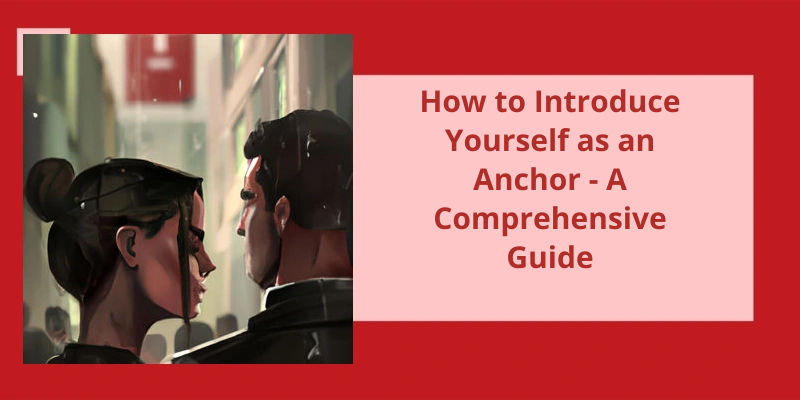As an anchor, your role is to not only inform your audience but to engage with them as well. One of the key aspects in establishing this connection is through the art of introduction. To introduce yourself effectively as an anchor, it takes more than just reciting your name and designation. It requires finesse, confidence, and an understanding of your audience. A compelling introduction sets the tone for the entire show, and can make or break the initial impression you leave on your viewers. It’s an opportunity to showcase your personality and establish your credibility. In this guide, we will explore the various elements that make up a successful introduction, from crafting your opening lines to maintaining your tone throughout the broadcast. So, whether you’re a seasoned anchor or a newcomer to the industry, this guide is here to help you master the skill of introducing yourself as an anchor.
How Do You Introduce Yourself While Anchoring?
When it comes to anchoring, one of the key aspects is getting your introduction just right. It’s important to remember that while you may want to talk about yourself and your accomplishments, the focus should always be on the event youre covering. Therefore, keep your bio/intro as brief and relevant as possible. In other words, don’t waste your viewers time talking about your entire life story. Instead, focus on why YOU are the best person to be anchoring the event, and what unique perspective you bring to the coverage.
Another important thing to consider when introducing yourself while anchoring is your tone of voice. You want to come across as confident and authoritative, but not arrogant or overbearing. Strike the right balance, and youll be able to connect with your viewers in an authentic way.
It’s also important to remember that anchoring is a team effort. You may be the face of the coverage, but youre working alongside producers, reporters, and other professionals. Therefore, don’t forget to acknowledge your colleagues and their contributions to the coverage. Not only will this show your viewers that youre a team player, but it will also help to foster a positive working environment among your colleagues.
When introducing yourself, it can be helpful to use visual aids, such as graphics or charts, to highlight key points about yourself or the event youre covering. This can help to break up the monotony of simply talking to the camera, and can make your introduction more engaging for your viewers.
Common Mistakes to Avoid When Introducing Yourself While Anchoring
- Don’t forget to introduce yourself first before starting the event.
- Avoid using complex or unfamiliar words that may confuse the audience.
- Avoid speaking too fast or too slow.
- Avoid being too formal or too casual.
- Avoid mentioning irrelevant information about yourself.
- Never forget to thank the audience for their attention and time.
- Don’t reveal too much personal information about yourself.
- Avoid making inappropriate or insensitive jokes or comments.
- Don’t speak negatively about the event or the organizers.
- Avoid reading your introduction word for word from a paper.
Now that we understand the concept of anchoring phrases and how they work, it’s important to explore their benefits in a bit more detail. From improving focus to reducing stress, these phrases can have a powerful impact on our lives when used consistently and effectively. Let’s delve into some of the key advantages of using anchoring phrases and how they can elevate both our mental and emotional well-being.
What Are Anchoring Phrases?
Anchoring phrases are a powerful tool that can help individuals to achieve a state of relaxation and focus. These phrases can be used as a way to ground oneself in the present moment and to overcome negative emotions and thoughts. By repeating a phrase that’s a strong positive connotation, individuals can anchor their minds and focus on the present.
To use anchoring phrases effectively, it’s important to choose a phrase that resonates with you personally. This will make it easier to repeat the phrase and to mentally connect with it. Some individuals find it helpful to write down their chosen phrase and to keep it in a visible place, so that they can be reminded of it throughout the day.
By mentally repeating a positive phrase, such as “I’m confident and capable”, individuals can boost their self-esteem and feel more at ease in social settings. This can have a positive impact on their interactions with others and can help them to form stronger social connections.
How to Create Your Own Anchoring Phrases
Creating your own anchoring phrases involves choosing specific words or phrases that evoke strong emotions or memories in your audience, and using them consistently in your messaging. This can help to establish a connection with your audience and improve the effectiveness of your communication. To create your own anchoring phrases, start by identifying the key emotions or memories you want to evoke, and then brainstorm words or phrases that can help you achieve this. Test your phrases with your audience to see which ones resonate the most, and then use them consistently in your messaging.
Introducing yourself can be a bit nerve-wracking, however, knowing how to start the conversation off on the right foot is key. One of the most important things to remember is to keep it concise and straightforward. Whether you’re at a job interview, meeting new people, or giving a presentation, the way you introduce yourself can make a big impact. So let’s dive into some tips on how to start an introduction about yourself.
How Do You Start an Introduction to Introduce Yourself?
Starting an introduction can be a daunting task, especially if youre meeting someone for the first time. However, there are many different ways to introduce yourself, and the most important thing is to be confident and genuine. One popular approach is to start by greeting your conversation partner or audience, which can help to break the ice and create a welcoming atmosphere. Using a friendly tone and making eye contact can also help to establish a connection and build rapport.
This lets your conversation partner or audience know who theyre speaking to, and can also help to establish your credibility and authority on the topic at hand. If you’ve a challenging or unusual name, it may be helpful to provide a pronunciation guide or a brief explanation.
In addition to stating your name, it can be helpful to mention why youre there, if relevant. For example, if youre meeting someone for a job interview or attending a networking event, you might want to mention your current position or your career goals. This can help to establish your purpose and provide context for your conversation.
When introducing yourself, it’s also important to be mindful of your body language and tone of voice. Avoid crossing your arms or appearing defensive, as this can create a barrier between you and your conversation partner. Instead, try to maintain an open and approachable posture, and speak in a clear and confident tone.
Finally, remember that introducing yourself is just the first step in building a relationship or connection. Be sure to listen actively to your conversation partner, ask questions, and show interest in their perspective and experiences. This can help to establish common ground and build trust over time.
Source: How to Introduce Yourself Professionally – BetterUp
Anchoring is an important skill that requires preparation, confidence, and good communication skills. In school functions, anchoring plays a vital role in engaging the audience, setting the tone, and ensuring that the event runs smoothly. A great anchoring script can make all the difference, and incorporating certain elements like the welcome line, lamp lighting and worship ceremony, swagat geet, chief guest’s message, principal’s address, cultural program, prize distribution, and thanks giving can make the event memorable for everyone involved. Here are some tips on how to start anchoring in school functions.
How Do You Start Anchoring in School Function?
Anchoring in a school function can be a nerve-wracking task for any student. However, with some proper preparation and a positive attitude, one can become a successful anchor in their schools function. The first and foremost thing to keep in mind while anchoring is to maintain a cheerful and friendly tone throughout. Your attitude towards the event determines the mood of the audience, so remember to stay enthusiastic and energetic.
When it comes to the anchoring script, it’s essential to have a well-structured plan. Start with a warm welcome line that sets the tone for the event. An example of a good welcome line is “Good evening, ladies and gentlemen, and a very warm welcome to all of you on this wonderful occasion.”. It’s best to keep the welcome line simple yet impactful to get the audiences attention.
Moving onto the lamp lighting and worship ceremony, it’s a significant aspect of any school function. The anchor needs to explain the significance behind the ceremony, it’s relevance to the occasion, and the importance of lighting the lamp. Remember to keep the explanation brief and to the point while maintaining the audiences interest.
Swagat Geet is another important segment of the school function. It’s a traditional way of welcoming guests and setting the tone for the event. The anchor needs to convey the meaning of Swagat Geet to the audience and inspire them to participate in it.
The Chief Guests message to the student is crucial as it sets the tone for the rest of the event. The anchor needs to introduce the Chief Guest and highlight their achievements before asking them to address the audience. During the speech, the anchor needs to maintain their composure and be attentive to the Chief Guests words to give a proper conclusion.
The Principals address to the student is a segment that shouldn’t be overlooked. The anchor should introduce the Principal and highlight their achievements before welcoming them to the stage.
The cultural program is the highlight of any school function, and it’s crucial to maintain the audiences attention during this segment. The anchor needs to keep the audience informed about the events proceedings while keeping the tone engaging and entertaining. During the various competitions, such as dance, singing, drama, and fancy dress, the anchor needs to keep the audience attentive and applauding the participants efforts.
During the prize distribution, the anchor needs to announce the winners and highlight their achievements. The anchor should also appreciate the efforts of all the participants and encourage them to continue their hard work. Lastly, during the vote of thanks, the anchor should thank all the participants, organizers, sponsors, and guests for their contributions to the event.
Remember to maintain enthusiasm and energy, have a well-structured plan, and keep the audience engaged throughout the event.
Importance of Researching and Preparing for the Event Before Anchoring
It’s crucial to conduct thorough research and preparation before anchoring an event to ensure a smooth and successful performance. This involves gathering information about the topic, the event schedule, and the audience. By doing so, the anchor can tailor their script and delivery to the audience’s expectations and needs, maintain the flow of the event, and avoid potential mistakes or misrepresentations. Overall, research and preparation help anchors deliver a professional and engaging performance.
Starting off an event with impactful dialogue is crucial to engage the audience and set the tone for the program ahead. There are various ways to begin an anchoring dialogue, including weaving in a story, asking a question, cracking a joke, or giving a summary of the event. In this article, we will take a closer look at some effective ways to start a dialogue for anchoring. Let’s dive in!
How Do You Start Dialogue for Anchoring?
Anchoring is a critical responsibility that requires a high level of professionalism, organizational skills, and communication abilities. An anchor sets the tone for an event or program and must know how to start a dialogue that captures the attention of the audience. There are several ways to start a dialogue for anchoring, each with it’s unique style and purpose.
Starting with a story can be a powerful way to capture the attention of the audience. It could be a personal anecdote that relates to the theme of the event or a fictional story that drives home the importance of the occasion. The story should be relatable, engaging, and set the tone for what’s to come.
Starting with some imaginary thought also works it’s magic. This approach opens up the imagination of the audience and creates an atmosphere of anticipation. It could be a hypothetical situation that relates to the theme of the event or a scene from a movie or book that speaks to the occasion.
Starting by asking a question is also a great way to start a dialogue. This approach makes the audience feel included and sets the tone for audience participation. The question could be rhetorical or factual and should relate to the theme of the event.
Make a claim about the program. This approach is also an effective way to grab the attention of the audience. A claim about the program could be something like “This is going to be the most exciting event of the year,” or “We’ve a line-up of world-class speakers who’ll inspire you.”. It’s essential to back up any claims with evidence or examples, so the audience knows what to expect.
Another strategy to start a dialogue is to crack some joke. It must be pertinent to the event and audience, staying aware of the audiences culture and customs relating to humor. A good joke eases any tension in the room and sets the tone for a relaxed and enjoyable event.
Alternatively, you can summarize what’s going to happen throughout the event. This approach can be informational and effective in creating anticipation towards whats about to happen. Going through the schedule and activities during the event will keep the audience engaged while taking them on a journey of what to expect.
The approach chosen must fit the occasion and audience while capturing their attention and setting the tone for the event. A confident and well-prepared anchor will have the audience hanging on to every word from the beginning to the end of the occasion.
FAQ about Starting lines for anchoring.
Q. Can starting with a joke ruin the tone of the event?
A. Yes, if the joke isn’t appropriate, it could put off some members of your audience.
Q. How do you summarize the event without giving away too much information?
A. You could mention the main activities or highlights of the event that will pique the audiences interest without revealing everything.
Q. Is it necessary to back up our claims about the program?
A. Yes, backing up our claims will give credibility to what we’re saying, and it will make the audience more excited about whats to come.
Common Mistakes to Avoid When Starting the Dialogue for Anchoring
When initiating the dialogue for anchoring, it’s important to avoid common mistakes that may negatively impact the outcome of the conversation. Some key things to avoid include using aggressive language or tone, asking leading questions, and being too focused on personal biases or opinions. Additionally, it’s important to stay open-minded and actively listen to the other person’s perspective to ensure a successful outcome.
Conclusion
With these essential qualities in mind, aspiring anchors can elevate their introductions and leave a lasting impression on their audience. By crafting a well-prepared script, practicing poise and tone, and delivering with authenticity, anchors can establish trust and credibility with their viewers, and ultimately succeed in their role as a trusted media figure. Whether it's anchoring a local news segment or hosting a national broadcast, mastering the art of introduction is a fundamental skill for any aspiring anchor looking to thrive in the competitive world of broadcast journalism. So, stay true to yourself, own your unique talents, and let your personality shine through. For only then can you truly captivate your viewers and become an unforgettable anchor.






